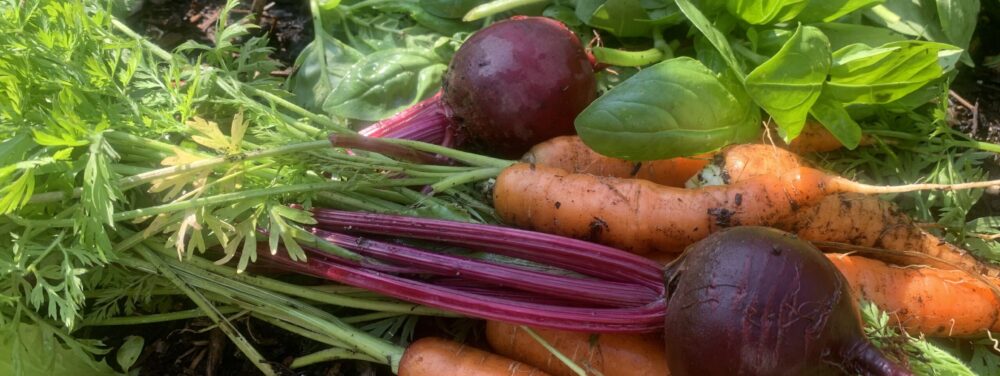Mmmmm! Homegrown lettuce! Every spring when I put that first mouthful of homegrown lettuce in my mouth, my taste buds sing! Homegrown lettuce has a big flavour. And lettuce is one of the easiest vegetables to sow and grow. Because lettuce loves cool weather, you can start growing lettuce in early spring. I also love that the plants take up little space. Even if you have only a small deck space, you can grow lettuce. We never get bored of the same lettuce variety. Tired of iceberg lettuce? Try growing a looseleaf, romaine, or a butterhead variety. Let me tell you the simple steps so you, too, can plant, grow, harvest, and eat your own lettuce.

Preparing To Plant Lettuce
Because lettuce loves nitrogen-rich soil, add compost and aged manure to the soil. Manure is high in nitrogen. Just make sure the manure you use has been aged. Or apply an organic fertilizer that is high in nitrogen.
Choosing A Location And Preparing Your Soil
Lettuce likes full sun, however, most lettuces can tolerate partial sun, too. While lettuce likes the sun, lettuce isn’t a fan of heat. If you have lettuce growing when the hot, summer sun arrives, try covering your lettuce with a shade cloth. Or grow lettuce in partial shade.
Grow lettuce in loose soil that drains well.
Lettuce isn’t picky about sharing soil with other vegetables. Try growing lettuce near beets, carrots, celery, broccoli, cucumbers, garlic, onions, spinach, squash, and strawberries. Some gardeners plant chives between their lettuce plants because chives help keep pests away.
Planting Lettuce From Seed
When To Plant Lettuce
Plant lettuce in early spring and late summer or early fall. Unless you have a heat-resistant variety, your lettuce likes cool temperatures. If it’s too warm (over 22 degrees Celsius), lettuce seeds may not germinate.
For an ongoing supply of lettuce, plant seeds every 2 weeks during the cooler months.
For a head start on spring growing, start lettuce seeds indoors in late February or early March. When the seedlings are 3 or 4 weeks old, harden them off, and then transplant outdoors.

How To Plant Lettuce
Depth to plant seeds: 1/8 inch to1/4 inch (barely cover the seeds)
Seed spacing: 6 inches between seeds, or sow the seeds closer if you want to keep the plants small or if you plan to thin the seedlings
Row spacing: 10 inches between rows
Keep the soil moist. Lettuce has shallow roots, so it needs moist soil to germinate and grow.
Label your lettuce with the name of the lettuce (variety), and the date you planted the seeds. Consider writing this in a garden journal, too.

Growing Lettuce
Many lettuces mature in 50–60 days. But you don’t have to wait that long. You can harvest your lettuce in about 30 days if you want smaller leaves.
Lettuce will bolt when it’s too warm. This means the centre of the plant will shoot up, flower, then produce seeds. At this stage, the leaves are bitter.
To keep pests away, consider spreading crushed eggshells at the base of your lettuce plants. If you notice holes in your lettuce leaves, or if your baby lettuce plants are eaten completely, you might have snails, slugs, or cutworms snacking on your lettuce plants.
If you notice damaged leaves, have a look at night (with a flashlight) for cutworms or their poop. Finding their excrement gives you evidence that the worms have been hanging out in your lettuce, turning the greens into a buffet. Cutworms are dark brownish, black, or green. Pick them off if you want to save your lettuce.
Harvesting Lettuce
There are 2 ways to harvest lettuce.
To harvest lettuce so it will grow back, just pick the leaves on the outside of the plant and leave the inner leaves to keep growing. This is called the cut-and-come-again method.
You can also remove the whole plant at the base, slicing the plant about 1 inch from the top of the soil.

Experimenting
If your lettuce is bolting quickly when the weather warms up, try growing heat-resistant or slow-to-bolt varieties like butterhead and romaine.
Because lettuce takes up little space, try planting lettuce between larger plants rather than in rows or containers. In summer, the shade from the larger plants might just be enough to keep them from bolting quickly. Learn more about companion planting with lettuce and other vegetables.
For a colour boost and a conversation-starter, add edible flowers to your homegrown salads!


